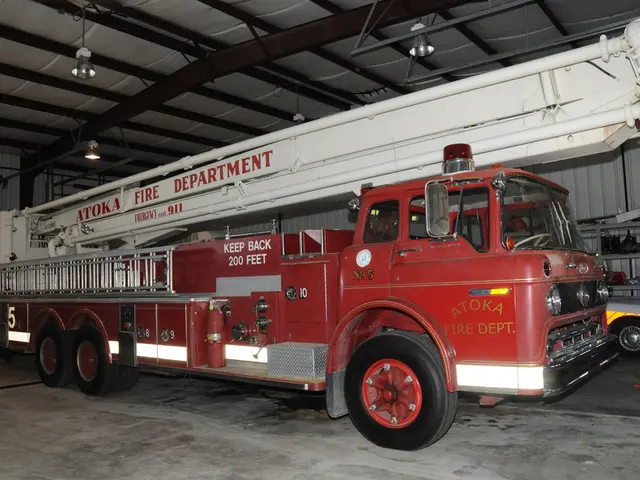"Legendary musicians like Rory Gallagher have relied on this shelf-busting advantage offered by pedals, so don't shy away due to its name - here are 20 methods to maximize your pedal's potential!"
Get More from Your Pedals: 20 Creative Tips and Tricks
Exploring the world of electric guitar tones has never been more exciting, and this humble pedal is the gateway to a sonic universe waiting to be explored. But mastering the art of pedals entails more than just selecting the right one and plugging it in. Here's a list of 20 creative ways to make the most of the pedals you already own, and indeed, open up a new sonic world.
1. Don't write off mainstream pedals:
There's been such a surge of interest in boutique pedals that it's easy to forget about the heavy-hitters in the effects industry. The Boss TR-2 Tremolo, for example, offers top-notch sonics in a standard package, proving that you don't necessarily have to spend a fortune to get great tones.
2. Find your niche:
Effects manufacturers, worth their salt, will ensure that their design philosophy flows consistently throughout all their products. So if you find yourself drawn to one pedal from a particular brand, be prepared to fall in love with the quality, vibe, and usability of other offerings from that maker.
3. Give an old pedal a second chance:
Sometimes, a pedal works better with certain amps than others. So if you change amps and notice a pedal that's been collecting dust, give it another spin with your new setup; it may just end up being the perfect match.
4. Invest in a good pedalboard:
While many guitarists have created stunning sounds using even the most basic pedalboards, a well-designed pro-grade 'board can make life easier and improve the quality of your sounds. They typically offer ample space for mounting power supplies and cable management, allow for easy foot access to each pedal, and often come with a convenient case for storage.
5. Consider using delay straight into your amp:
It's become common knowledge that delay pedals should go into the effects loop to avoid overly-distorted repeats. However, remember that with effects, no rule is absolute – sometimes a grittier, swampier sound can be glorious. Trying both methods and deciding what works best for you is key.
6. Embrace the power of an 'always-on' boost:
Playing through a clean or near-crunch amp can sometimes feel unforgiving. To create a more flattering, expressive tone, use a clean boost to push the amp harder, promoting natural compression and a fuller sound.
7. Place fuzz pedals ahead of other effects, generally:
Many vintage and vintage-inspired fuzz pedals require a direct connection with your guitar pickups to unleash their full warmth and expressiveness. Experiment with placing fuzz pedals at the start of your chain to achieve tastier tones.
8. Use modulation effects subtly:
Chorus and phaser pedals can augment clean tones with subtle movement and a sense of space, even if the effect is barely perceptible. And don't forget that some classic modulation pedals have built-in preamps that can enhance the tonal quality of your signals.
9. Give analog pedals a try:
While digital effects offer incredible versatility and editability, don't discount the charm and character of genuine analog-circuitry pedals. The J Rockett Tranquilizer phaser, for example, provides a level of charisma that even high-quality digital models struggle to match.
10. Dial in settings at gig volume:
If you have an upcoming gig and want your settings to translate smoothly to the stage, consider hiring a rehearsal studio equipped with a loud PA system. This will help you fine-tune your effects and amp settings for live scenarios and prevent any unexpected letdowns.
11. Use the pencil analogy:
Envision your drive tones as various pencils, each with a unique characteristic:- Overdrive pedals like Free The Tone's SS1-V String Slinger bring crispness and clarity for cutting through a mix.- Four-knob overdrive pedals such as the J Rockett Archer Select offer flexible tonal sculpting and are perfect for adapting to different amps and situations.- Get wild with display-worthy fuzz pedals such as the J Rockett 45 Calibre.
12. Get creative with four-knob drives:
While three-knob overdrives have a nostalgic appeal, four-knob overdrives like the ThorpyFX Warthog can offer greater tonal flexibility, making them more adaptable to various amps and effects combinations.
13. Have a portable pedalboard for spontaneous jams:
A smaller, lightweight pedalboard with only three core effects (e.g., overdrive, tremolo, and delay) can prove invaluable for those times when you just want to hop in the car and join a casual jam with friends.
14. Consider an all-in-one solution:
Line 6's HX Stomp multi-effects unit or the Keeley DDR (Drive, Delay, Reverb) can replace an entire pedalboard while providing ample tonal possibilities. Not only will your 'pedalboard' be portable, but it can also fit inside your pocket!
15. Take control with your volume knob:
Experiment with volume swells, hitting your tone sweet spots by adjusting the guitar's volume control while playing through various pedals and amps. This simple trick has been employed by legendary players such as Mick Taylor and Rory Gallagher.
16. Use traditional pedals with digital multi-effects:
If you own a digital multi-effects unit like Line 6 Helix or Boss's GT-1000, you have the option to employ your favorite stompboxes within the internal signal chain. So, if you need the programmable versatility of an all-in-one multi-effects but long for the sound of a beloved vintage phaser, for example, you can often have the best of both worlds.
17. Use gel instead of Velcro:
According to Daniel Steinhardt of That Pedal Show, gel tape is an excellent alternative to using Velcro due to its strong hold without damaging your pedals. Plus, it's easy to remove and can adhere to rubber bases, making it ideal for Boss compact pedals.
18. Explore the treble booster effect:
Despite its misleading name, the treble booster is a versatile tool for pruning bass frequencies and enhancing upper mids, especially when playing through cranked amps that can lose clarity when pushed too hard.
19. Blend wet and dry signals:
Some modern compression and overdrive pedals allow you to combine wet (effected) and dry (unaffected) signals for subtler and more organic tones. If you crave natural sounds that flatter, sustain, and boost in a sensitive and nuanced way, pedals with a wet/dry blend control can unlock new possibilities.
20. Experiment with every pedal you come across:
Like guitars, the best effects are those that connect with you on a personal level. Whether you're a beginner or a seasoned veteran, keep an open mind, explore different brands, price ranges, and styles, and be fearless in your quest for the perfect sounds.
- A popular pedal to consider, even among the rise of boutique pedals, is the Boss TR-2 Tremolo, which delivers high-quality tremolo effects in a standard package without the hefty price tag.
- When drawn to one pedal from a particular brand, be prepared to discover the consistency in quality, vibe, and usability of other offerings from that manufacturer.
- Sometimes, a pedal may work better with certain amps rather than others; so, if you change amps and notice a pedal that's been sitting idle, give it another try with your new setup—it may just be the perfect match.
- A well-designed pedalboard can make life easier, improve sound quality, and offer space for mounting power supplies and cable management, among other advantages.
- Instead of always placing delay pedals into the effects loop, try routing the effect directly into your amp, especially to create a grittier, swampier sound.
- To create a more expressive tone, use a clean boost pedal to push your amp harder, encouraging natural compression and a fuller sound, especially when playing through clean or near-crunch amps.
- Many vintage and vintage-inspired fuzz pedals require a direct connection with your guitar pickups to achieve optimal warmth and expressiveness; experiment with placing the fuzz pedal at the beginning of your chain to unleash its full potential.
- Use modulation effects such as chorus and phaser pedals subtly to add movement and a sense of space to clean tones, even if the effect is barely perceptible, and remember that some classic modulation pedals come with built-in preamps that enhance tonal quality.
- Analog pedals with genuine analog circuitry can offer a level of charm and character that digital models often struggle to match, like the J Rockett Tranquilizer phaser.
- Fine-tune your effects and amp settings for live scenarios by rehearsing in a studio with a loud PA system, ensuring that your settings translate smoothly to the stage and preventing unexpected letdowns.
- Picture your drive tones as various pencils, with each having a unique characteristic; for example, overdrive pedals like the Free The Tone's SS1-V provide clarity to cut through a mix, while four-knob overdrives such as the J Rockett Archer Select offer flexible tonal sculpting.
- Four-knob overdrives, like the ThorpyFX Warthog, provide greater tonal flexibility compared to three-knob overdrives, making them more adaptable to various amps and effects combinations.
- A smaller, lightweight pedalboard with just three core effects can be essential for spontaneous jams with friends.
- All-in-one solutions such as Line 6's HX Stomp or the Keeley DDR can replace an entire pedalboard while offering ample tonal possibilities, making them portable and easy to store.
- Utilize your volume knob creatively to experiment with volume swells, hitting tone sweet spots by adjusting the guitar's volume control while playing through various pedals and amps, as demonstrated by legendary players such as Mick Taylor and Rory Gallagher.
- Combine your favorite stompboxes with a digital multi-effects unit, such as Line 6 Helix or Boss's GT-1000, to take advantage of the programmable versatility of an all-in-one multi-effects while retaining the sound of a beloved vintage phaser, for example.
- For a stronger hold without damaging your pedals, consider using gel tape instead of Velcro, especially for Boss compact pedals, as suggested by Daniel Steinhardt of That Pedal Show.
- The treble booster is a versatile tool for pruning bass frequencies and enhancing upper mids, especially when playing through cranked amps that can lose clarity when pushed too hard.
- Some modern compression and overdrive pedals allow you to combine wet (effected) and dry (unaffected) signals for subtler and more organic tones.
- Be fearless in exploring every pedal you come across and keep an open mind, as the perfect effects can often be discovered through trying out different brands, price ranges, and styles.







